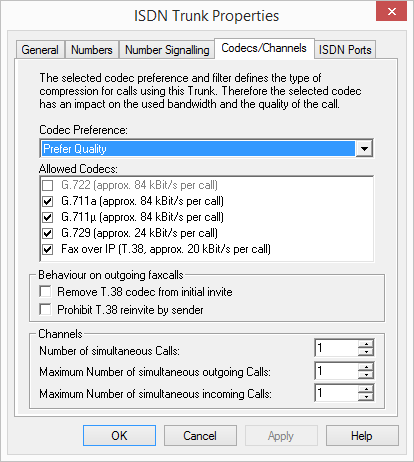The "Codecs/Channels" Tab

The following settings can be made:
Codecs
If the Codec priority "Prefer Quality" is selected, the Codecs are provided in the sequence G.722, G.711a, G.711µ, G.729 or Fax over IP. The Codec G.722 is deactivated by default, because it would only be supported up to the ISDN gateway. Specify the filter(s) you want:
The voice data is slightly compressed. This keeps the packet delay time in the LAN (Local Area Network) to a minimum. A voice connection requires approximately 64kbits/s.
High compression. A voice connection
requires approximately 24kbits/s.
requires approximately 24kbits/s.
In this case, the special fax protocol T.38 is used, which takes the set-up of the IP network into consideration. A fax connection using T.38 requires approximately 20kbits/s.
If the Codec priority "Prefer low bandwidth" is selected, the Codecs sequence changes to G.729, G.722, G.711a, G.711µ, Fax over IP. The Codec G.722 is deactivated by default, because it would only be supported up to the ISDN gateway. The aim here is to use as little bandwidth as possible. Here too, specify the filter(s). G.722 is deactivated, as this Codec is not supported for an ISDN trunk.
If there are several voice codecs selected, SwyxServer will filter voice data according to the current settings. The communicating sides will have to decide which voice codec to use.
It won't be written in the change log, if a Codec was activated or deactivated. See also Change log.
Action on fax receipt
When a fax connection is set up, the T.38 protocol is negotiated between the two devices involved. Certain variants of this negotiation may not be supported by some IP adapters. Use the following filter options to establish compatibility with such devices.
Some IP adapters cannot correctly interpret an initial connection request which includes T.38 as well as voice Codecs.
If this option is set, SwyxServer removes T.38 from the initial connection request. The fax devices first set up a voice connection and then switch to the fax protocol T.38 because of the fax tone (CED tone, 2100Hz).
The receiving fax device switches to T.38 after detecting the fax tone (CED tone, 2100Hz). Alternatively, the switch to T.38 can be carried out by the sending fax device.
Some IP adapters don't support switching by the sender.
If this option is set, SwyxServer suppresses a switch to T.38 by the sender.
If the receiving side involves a combined phone/fax device (fax switch), a fax data transmission is impossible when the option "Prohibit T.38 reinvite by sender" is activated.
The filter options can only be set when the Codec "Fax over IP (T.38...)" is activated.
Channels
Specify how many channels (connections) should be simultaneously routed over this trunk. You can also determine how many outgoing and/or ingoing connections are established at most.
Example:
You use a SX2 SinglePRI, which means that a maximum of 30 lines are available. If you configure a maximum of 10 channels for outgoing calls, then 20 lines remain free for you to be called.
If channels were added or removed, you will find these changes in the change log. See also Change log.
Last modified date: 01/24/2024